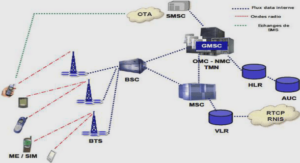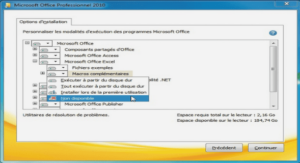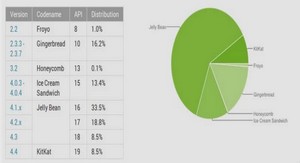C-RAN Structure
A basic architecture of C-RAN including the RRHs connected to the BBU pool via multiple fronthaul connections (Wu et al., 2015) :
– RRH: In contrast to the traditional cellular BS whose BBUs are internally integrated, RRH is only equipped with radio units and spatially separated far from the BBUs, which are located in the cloud center. In fact, each RRH only accounts for the compression and transmission/reception of radio signals to/from users, which has similar functionalities of small cell BSs in heterogeneous networks (Nguyen et al., 2013, 2012a,b; Nguyen & Le, 2014b,a; Chandrasekhar et al., 2008). In particular, a RRH can operate on both uplink (UL) and downlink (DL) to communicate with its served users where its main tasks include the digital processing, digital to analog conversion (DAC), analog to digital conversion (ADC), power amplification, filtering, RF transmission and hnadling interface of fronthaul link for the data transportation to/from the BBU pool.
– BBU Pool: BBU pool consists of multiple BBUs which collocate in the cloud center. BBU pool’s main functionalities include the radio resource control (RRC) in Layer 3, transport medium access control (MAC) in Layer 2 and channel coding/decoding, quantization, antenna mapping, resource block mapping, sampling, modulation, inverse fast Fourier transform (IFFT) in Layer 1 (c.f. Fig. 1.3). By centrally coordinating all the central processing units (CPUs), a BBU pool can handle the sophisticated baseband signal processing and even compute optimal radio resource allocation such as transmit beamforming or power for the RRHs’ transmissions/receptions. In general, a BBU pool often applies two transpiration mechanisms: compression-after-precoding and compression-before-precoding. In this first mechanism, the BBU pool precodes the beamforming vectors intended for the RRHs, then compresses the precoded data and forwards it to RRHs via the corresponding fronthaul links. In the second one, the BBU pool forwards the compressed beamforming vectors to RRHs, and the RRHs precode the received signals and transmit them to the UEs.
– Fronthaul link: A fronthaul link can be a wired or wireless connection that connects the BBU pool to the corresponding RRHs using a specific interface. The in-phase/quadrature (I/Q) data transmission protocol between RRH and the BBU pool in the fronthaul link can be bidirectional such as Common Public Radio Interface (CPRI) (Doc, 2013), Open Base Station Architecture Initiative (OBSAI) (Doc, 2006) and Open Radio equipment Interface (ORI) (Doc, 2011). Fronthaul links can be generally categorized into two types: ideal and non-ideal limited fronthaul. In the ideal fronthaul case, optical fiber cables of high capacity are used to guarantee fronthaul data transportation with low latency and high reliability. In contrast, the non-ideal limited fronthaul often refers to wireless communications to offer an inexpensive and flexible solution for fronthaul data transmissions. Due to the challenges of wireless channel attenuation and wireless transmissions’ concurrency, non-ideal fronthaul capacity is limited at some finite value, which set a remarkable upper-bound for the potential performance of C-RANs.
C-RAN Functional Split
A typical C-RAN contains a certain set of functionalities belonging to either the BBU pool or RRH. However, these functionalities are fixed at one place and can be adaptively equipped at the BBU or RRH depending on the operator’s demand. Based on the quality of the fronthaul connections and the functionalities equipped at the BBU pool and each RRH, C-RAN operation can be categorize .
– Full centralization: The BBU pool is responsible for the functions of baseband physical layer, MAC layer, and network layer which manage the operation of all RRHs. The BBUs that operate in this coordination level contains all the tasks of signal processing and resource management similar to the traditional cellular BS but suffers heavy burden from the limited fronthaul conditions since extremely high data traffic is transmitted between the RRH and the BBU pool via the fronthaul links. The required fronthaul data rate, denoted as RFH which is responsible for I/Q data transportation, can be computed as (Wübben et al., 2014) RFH = 2N0 fsNQNR .
where N0, fs,NQ, and NR are the oversampling factor, sampling frequency, quantization bits per I/Q and number of receive antenna, respectively. This coordination level embraces the existence of low-cost RRH, where no digital processing unit is required. However, utilization of signal processing and beamforming techniques is necessarily optimized to reduce the traffic within the fronthaul link and harness the advantages of this setting.
– Partial centralization: The RRH is functioned with some additional baseband signal processing functions beside the RF capability. This means that the BBU pool tasks are facilitated with less operations on the baseband signal processing, while still include the MAC and network layer tasks. At this level, the signal processing tasks such as forward-errorcorrection or decoding are executed at the RRH side, resulting in the pure MAC payload inside the fronthaul link to/from the BBU.
Virtualization in C-RANs
Virtualization technology basically separates resources into virtual entities from the underlying physical hardware (Liang & Yu, 2015; Hawilo et al., 2014). In C-RANs, virtualization is used to create a virtualized BBU pool that is operated on different commercial servers. In fact, the virtualized network functions and protocols can be deployed in a virtualized network that connects several virtual machines through virtual links, enabling the division of computing-related resources existing in the BBU pool such as data storage, memory size, CPU capacity to run different applications, operating systems and controls. Thus, C-RAN network virtualization reduces the cost of hardware utilization and increases the scalability of dynamically activating/deactivating the virtual resources. It allows C-RAN to inherit the technologies related to cloud computing and virtualization such as the Network Function Virtualization (NFV) and Software Defined Network (SDN) in order to flexibly support a broad range of services and multiple operators that are not achievable in traditional RANs.
Softwared Defined Network
SDN is the technology which splits the control and data planes. It enables the programmability and global management of network control via the external applications and the underlying infrastructure. These network controls can be reprogrammed, abstracted, and adjusted to suit with various applications and network services. Moreover, SDN based controller can offer available open interfaces between the devices and network controllers of different protocols from various vendors. With these capabilities, SDN is the key technique to provide an effective control plane in C-RAN’s development towards 5G. Although SDN is not the topic focused in this thesis, it is briefly dicussed in this paragraph to complete the C-RAN concept.
INTRODUCTION |




